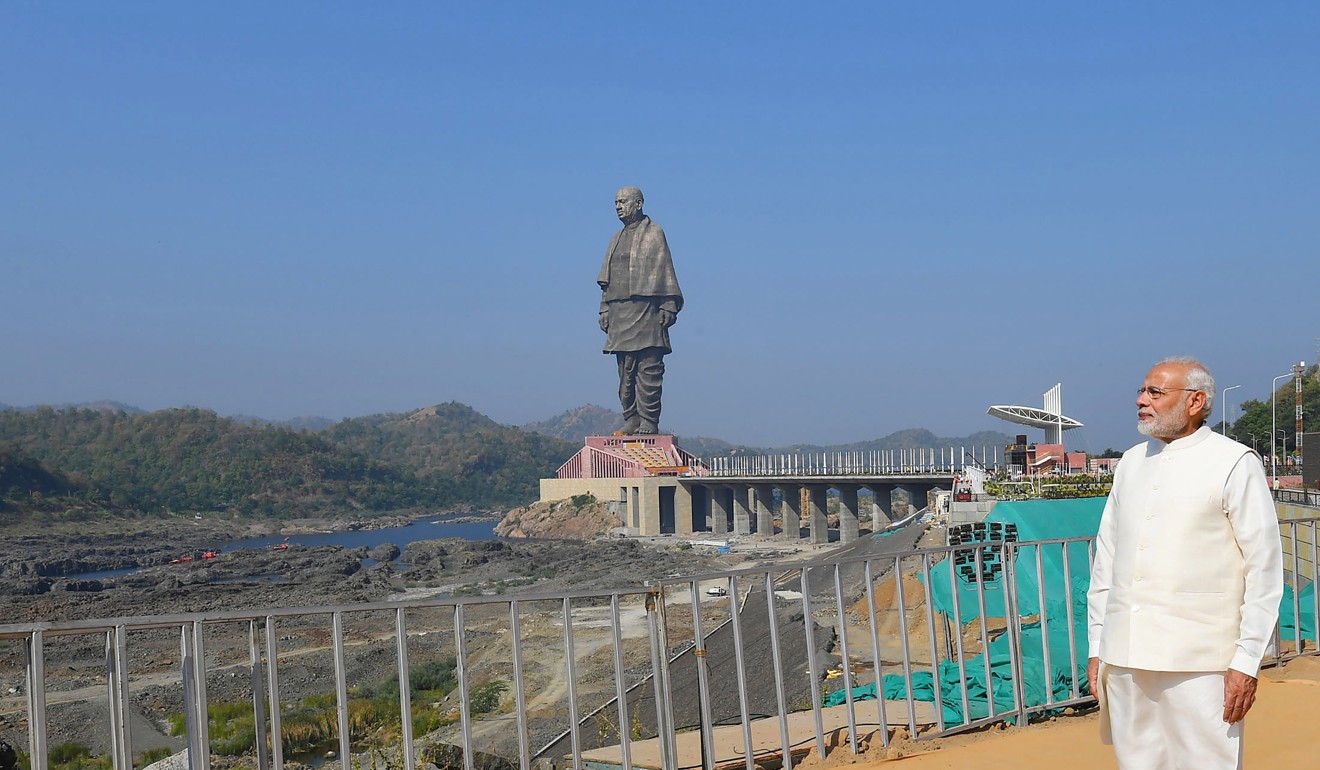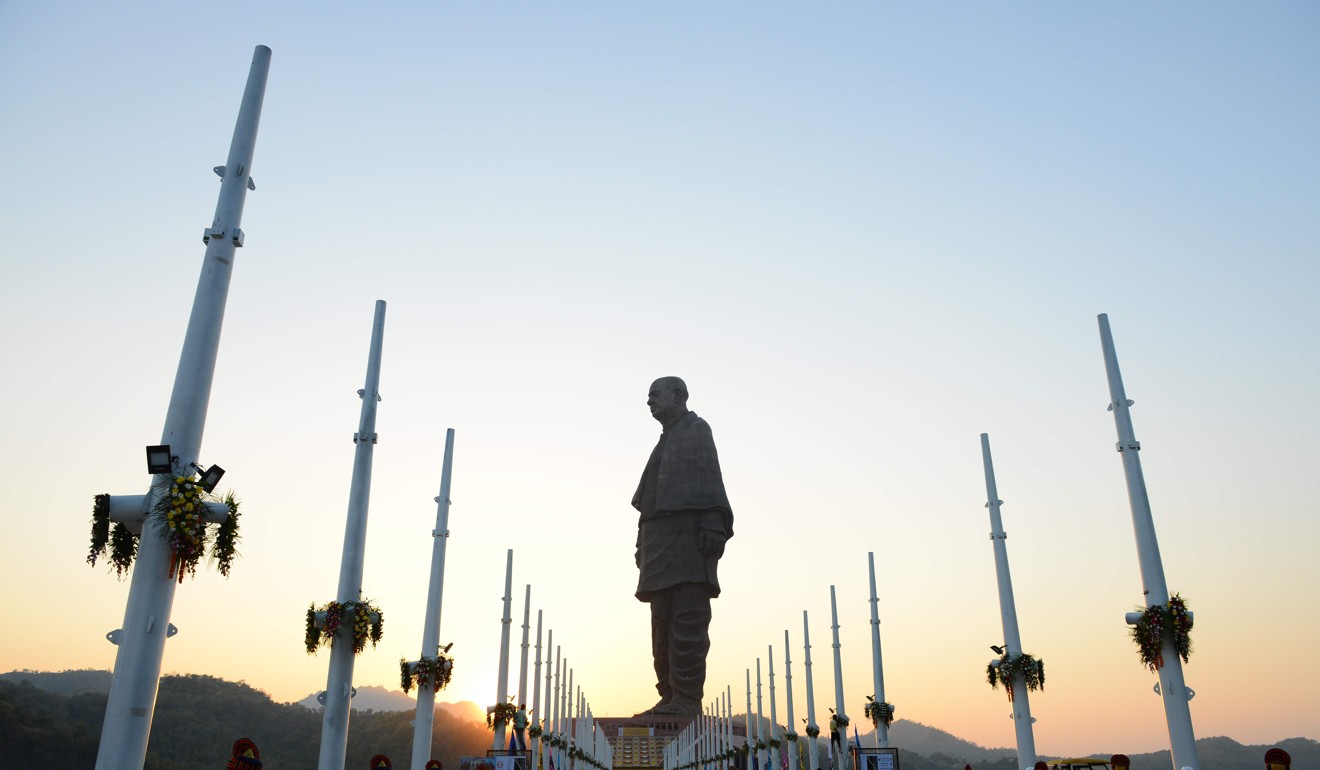
India has world’s largest statue, but satisfying Modi’s ego still a tall order
- Construction is twice as high as Statue of Liberty.
- Criticism includes a campaign of letters written in blood from tribal people displaced by the project.
- The US$403 million statue is seen as another bid from Modi to unseat the legacy of India’s first prime minister, Jawaharlal Nehru
The colossal structure dubbed the “Statue of Unity” is an effigy of Sardar Patel, an independence-era figure popularly known as the “Iron Man of India”.
Modi’s push for its construction is seen as a bid to appropriate the legacy of India’s freedom movement leaders, including Patel.
It stands 182 metres in height, or twice that of the Statue of Liberty in the United States, and was built at a cost of US$403 million in a remote part of Gujarat, the country’s westernmost state.
The inauguration, which took place on the 143rd anniversary of Patel’s birth, saw Indian Air Force jets in the sky and cultural troupes from across India dancing on the earth below.
The ceremony attracted sharp criticism for the spectacle, in addition to long-standing concerns over whether the country could afford to spend so much on a statue.
It’s Modi and Bose vs Gandhi and Nehru in India’s battle of legacies
The project had also come under fire for the natural resources destroyed in its construction, and the displacement of as many as 75,000 tribal people from the area in which it was built.
“The Modi government destroyed our natural resources and tribal culture. Our constitutional rights are not upheld. Modi is our enemy,” said Praful Vasava, a tribal activist leader who spearheaded protests against the statue.
Vasava told the Post nearly a million tribal people would not cook food on Wednesday as a mark of protest. His figure is not independently verifiable, but reports from the area and other observers suggest a large number of the tribal population from Gujarat and its neighbouring states are protesting.

According to local media reports, at least 16 tribal leaders were detained on the eve of the inauguration. Vasava added the tribal people would soon send letters written in their blood to Modi in a further protest against the statue.
Farmers and tribal activists threatened large-scale protests against the unveiling forcing the government to deploy thousands of security personnel. The region has a history of activism against several other projects, such as a planned series of dams on the Narmada river.
A pet project of Modi’s, the Patel statue was erected in the relatively short time of 33 months by 250 engineers and 3,400 labourers.
China’s Spring Temple Buddha statue, the previous record holder for tallest statue, took 11 years to finish, while the Statue of Liberty took nine years.
‘Surgical strikes’: As Modi plays politics with Indian army, soldiers pay with their lives
The Patel statue was built to withstand 180km/h winds and earthquakes of up to magnitude 6.5. From a viewing gallery in its chest, up to 200 visitors can have an aerial view of picturesque mountain ranges and the Narmada river.
“This is a historic event for all Indians,” said a visibly elated Modi in his hour-long address. “I dedicate this Statue of Unity to the nation. No Indian will forget this day.”
Modi’s top ministers led rallies in support of the statue in multiple other cities such as Mumbai and New Delhi.
“Patel, a titan of India’s freedom struggle, unified the country and stopped it from disintegration. His statue is a symbol of India’s integrity,” Modi said, peppered with potshots at his critics and copious references to other pet projects such as his goods and services tax and health care initiatives.
Political analysts say Modi’s monument to Patel – India’s first home minister, who is credited with unifying the country from its fragmented state soon after independence from Britain in 1947 – is a conscious decision to unseat the legacy of the country’s first prime minister, Jawaharlal Nehru, whose descendants are Modi’s opponents.

The Modi administration hopes to turn the statue into a tourism hub and is developing infrastructure such as motorways and hotels around the structure.
“In a nutshell, the project is an individual’s ego and Modi’s whim. I don’t see any logic in establishing the tallest of the tall statues except for satisfying Modi’s ego,” said Ghanshyam Shah, a Gujarat-based political scientist and author of the book Social Movements in India.
Nevertheless, others see some long-term value in projects such as the statue, and feel they will attract global attention to India.
“Criticism will be around for another four to five years because of the bureaucratic mindset to look down upon any project of such a grand scale,” said Madhav Nalapat, honorary director and Unesco peace chair at Manipal University.
India’s Sikkim airport borders China in sign of Modi’s intent
“Like India’s Taj Mahal or the Egyptian pyramids, which could also be argued as extravagant, Patel’s statue will also have a long-term value. It will be a place to visit for those nostalgic about the freedom struggle.”
Jiangxi Tongqing Metal Handicrafts, a foundry in southeastern China, was tasked with the bronze panelling of Patel’s statue. The firm shipped about 6,500 bronze panels, weighing just under 2,000 tonnes, to enclose the towering figure. Modi’s political opponents ridiculed him for bringing expertise from China instead of utilising local resources for an iconic project.
Ironically, Patel’s statue is expected to lose its world’s-tallest tag in three years to a sculpture of 17th century Maratha king Shivaji Bhonsle that is being erected in Mumbai.
The proposed Chhatrapati Shivaji Memorial, expected to be wrapped up in 2021, will stand at 212 metres.
Additional reporting from Associated Press

